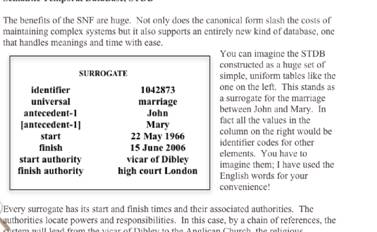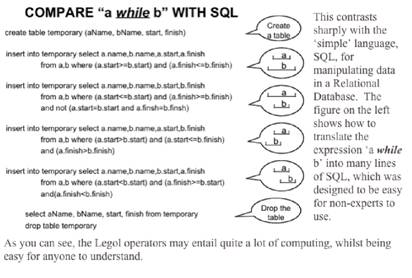Dear Ronald,
After reading your paper “”, I
found the STDB description to be very interesting, and possibly very effective
in developing semantic systems. It appears that every entity in your
semantic model has the structure of what you call a “Surrogate”:

It appears that a single table (SurrogateS)
with all Surrogates could have entries for all object TYPES or CLASSES (where
the authorities are the type constructors) and also object INSTANCES (where the
authorities might be the callers of the type constructors).
In particular, I like your mapping of common
English temporal words such as “while” into straightforward
database operations that can be triggered by reasoners:

Do you see the Measur ontology approach as
well suited to English logical processing, as in controlled English
programs? Have you worked on English speaking or Q&A programs that
could map that kind of database representation into more conversational
English?
Your progress in that direction might be
enlightening; please share it with us.
-Rich
Sincerely,
Rich Cooper
EnglishLogicKernel.com
Rich AT EnglishLogicKernel DOT com
9 4 9 \ 5 2 5 - 5 7 1 2
From:
ontolog-forum-bounces@xxxxxxxxxxxxxxxx
[mailto:ontolog-forum-bounces@xxxxxxxxxxxxxxxx] On Behalf Of Ronald Stamper
Sent: Monday, April 02, 2012 9:54
AM
To: [ontolog-forum]
Subject: Re: [ontolog-forum] metaphysis,semantics and the
research program of ontologies
Dear colleagues,
Interesting
discussion.
On metaphysics,
semantics, context, ontology etc. we have taken a different route. It
serves well in practical information system engineering and I think it could
contribute to the semantic web and “ontology” in the computer
science sense.
I’ll provide,
from the point of view of our methods, brief notes on a few of the topics
mentioned in the discussion. I’m sorry that it turns out to be
longer than intended.
SEMANTICS: The
problem of meaning requires us to examine the relationships between things A
(in the role of signs) that stand for things B, regarded as objects in the
reality that the sign system can represent. For that limited problem, we
must make a commitment about our understanding of the reality involved in this
meaning relationship. We may need only a limited kind of solution to
the metaphysical issue of ontology. We accept that limitation. But
we do not accept the limitation that seems to govern the main body of work on
the Semantic Web (OWL-related, for instance) that signs stand for other
signs. We are focused on the world beyond the signs.
ONTOLOGY: For
all practical engineering purposes, the only things that exist do so because a
responsible agent can perceive them in the here-and-now. This Presentist
version of Actualism induces careful examinations of time, signs and
responsibility, among other things. (Computing devices are not
responsible agents.)
PERCEPTION: An
agent experiences a continual flux of events and actions which it makes sense
of by discovering invariant repertoires of behaviour that enable it to survive
and to avoid the slings and arrows . . . . (See James
Gibson’s Theory of Affordances). The recognition of affordances can be
learned by individuals and evolved by a species.
SUPREME
CATEGORY: affordance = invariant repertoire of behaviour.
REALISATION: For an
agent, a thing only exists when that affordance is available or realised and
this entails the coexistence of all its ontological antecedents (see
dependency, below).
UNIVERSAL/
CATEGORY: An affordance, as a recognisable, ‘useful’ ability to
employ an invariant repertoire of behaviour (example: walk is usually available
to a person from about 1 year until old age but realised only during some
particular intervals).
PARTICULAR/
INSTANCE: A universal (ability) may be realised for many particular, shorter,
possibly overlapping periods within its existence (each time a person walks,
for example, or encounters a dog). The agent may not necessarily be able to
discriminate between those particulars (quite a complex process of discovery).
DIRECT KNOWLEDGE:
An agent constructs its own reality by discovering the repertoires of behaviour
afforded by the combined functioning of its own structure and the chaotic world
it occupies. (No simple boundary between the body and environment of the
agent?)
ONTOLOGICAL
DEPENDENCY: An agent that realises (has available) a certain affordance may be
able to realise further ontologically dependent affordances. For example
Agent upright walk
or, for joint
affordances
Agent (paper [medium] WHILE pencil [tool]) draw
Here, draw has two
ontological antecedents; no affordance has more than two.
ROLES: Relative to
every realised affordance, every antecedent plays a role. Direct
antecedents often have natural language names (in the example above
‘medium’ is dubious) but, at least, they have default code names.
ONTOLOGICAL/
SEMANTIC SCHEMA: The schema resulting from the successive application of the
ontological dependency constraint depends on a particular root agent. It
imposes tight constraints on the existence of things in the perceived reality
all of which is the ‘private’ reality of that agent.
RESPONSIBILITY: In
a biological sense, an isolated agent is responsible for the affordances it
discovers and is responsible for using them, in that it must endure the
physical and ecological consequences of any behaviour prompted by the
affordances it recognises.
PRESENT: = the
coexistence of an agent’s affordances. An agent with memory (internally
generated and maintained signs) can transcend its limitation within the
present. For any realised affordance, it will remember (retain a signs
for) the periods when it did not exist and for its start and finish events.
TIME: The starts
and finishes of realisations, registered with the benefit of memory, begin the
development of a notion of time. Moments of time exist only
semiologically; they cannot be visited for perception as sustained repertoires
of behaviour, as other things are perceived, they can only be signified before
or after their existence.
SIGNS: In addition
to the development of memories, agents will evolve the perceptions of signs
through metonymical and metaphorical relations to what they stand for.
Agents of the same phenotype will discover how to share their naturally similar
repertoires of signs.
SOCIETY: An
isolated agent can construct only a rather limited reality. That changes
when a number of agents collaborate by using signs and learn the affordances
discovered by others while also learning to discover collectively affordances beyond the abilities of any of their individual
members.
SEMIOLOGICAL
KNOWLEDGE: Supremely in the case of humankind, a society of agents becomes the
effective root agent, creaing the larger reality that its members share.
The Actualist ontology compels one to examine in
a thorough and rigorous manner the use of signs for constructing past,
future, possible, fictional and various social 'realities'.
AUTHORITY: An
isolated agent is the only possible authority for making or recognising any
change in its perceived reality. A society, consisting of many
responsible agents, assigns authority to appropriate members as agents who
register or decide upon changes. In many cases, starts and finishes are
authorised by norms. The condition that triggers the norm’s application
will distribute authority over possibly many agents who determine the facts
that the condition takes into account.
RESPONSIBILITY: In
the social sense, responsibility is the obverse of authority (devolved or
usurped) and it indicates with whom to communicate to obtain information or
challenge it.
SEMANTIC TEMPORAL
DATA BASE: The STDB serves as a symbolic surrogate for the perceivable
reality, each realisation represented by a relational tuple consisting of
identifiers representing
surrogate identifier
category/ universal
first antecedent
[second antecedent]
start (contemporary realisation)
finish (contemporary realisation)
authority for start (agent, norm, speech act)
authority for finish (agent, norm, speech act)
LANGUAGE: One may
make assertions or ask questions about the subject domain; that requires words,
names or numbers (possibly pictures). These are joint affordances, each
ontologically dependent on the realisation and the relevant language(s) or
register(s) employed by the people using the information. To accommodate
different cultures, expressions may be needed rather than single words to serve
some language or other for various affordances.
CONTEXT: Any
sentence formed using the signs associated with the schema and particulars
recorded in the STDB will use operators – WHILE, ORWHILE, WHILENOT,
BEFORE etc – that take account of the start and finish events. The
times or temporal relationships, authorities and the antecedents structures for
all the realisations involved all to the context. Context is limitless, always
extending beyond any degree of formalisation we may achieve.
“ONTOLOGY”
(in the computer science sense): The ontological dependency schema, which is
very stable (indeed it displays empirically the properties of a canonical form
- always open to refutation), can be developed gradually by accretion from
successive applications.
GENERIC-SPECIFIC:
The generic-specific relationships that dominate most Semantic Web
“ontologies” tell us about relationships among certain categories;
they are perceptual norms that summarise other norms – cognitive, deontic
or evaluative. Each has a period of existence with a start, a finish and
associated authorities. G-S relationships included in an ontological dependency
schema help to abbreviate it.
APPLICATIONS: We
use these ideas for specifying purely human information systems as systems of
social norms, with the ontological dependency schema providing the core of the
perceptual norms. We are now able to generate supporting computer applications
for the human system automatically - still testing the limits.
PROJECT: We’d
like to initiate a programme for the incremental development of a public domain “ontology” based on the concept
of ontological dependency. Finance? Any suggestions?

